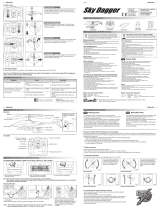
8
EN
Transmitter Setup (BNF)
Program your transmitter before attempting to bind or fl y the helicopter. Transmitter
programming values are shown below for the Spektrum DX6i, DX7s, DX6, DX7, DX8,
DX9, DX18 and DX20.
The fi les for models using Spektrum
™
transmitters with AirWare
™
software are also
available for download online at www.spektrumrc.com.
Your helicopter is also compatible with Spektrum DXe radios with software version 1.3 or
higher. Use the directions below to reverse channel 6, or use the appropriate program-
ming cable and the PC or mobile app to program the DXe. We recommend downloading
the Blade mSR S DXe model setup available at www.spektrumrc.com.
If you are programming your DXe using the PC or mobile app, make sure the
"Transmitter Channels" value is set to the default of 7. If for any reason this value is
changed to 9, the mSR S will bind to the DXe, but will not respond to control inputs.
If your DXe was included in another Blade Ready To Fly (RTF) helicopter, the transmitter
software will have to be updated using the appropriate programming cable and either the
PC or mobile app available at www.spektrumrc.com. Please note, the switch confi gura-
tion used for DXe transmitters included with the Blade 230 S RTF and Micro AH-64
Apache RTF varies from the standard DXe layout.
To use the DXe transmitter with the Blade mSR S, channel 6 must be reversed.
To reverse channel 6:
1. While powering on the DXe, hold the left and
right sticks in the top-inside corners as shown.
2. Re-center the sticks after the transmitter
beeps. The LED will fl ash slowly.
3. To select a channel to reverse, move the
right stick to the left or right and allow it to
re-center. Move the stick to the right to select
the next channel. Move the stick to the left
to select the previous channel. The LED will
fl ash rapidly corresponding to the channel
selected, as shown in the table. Select
channel 6.
4. To reverse the selected channel, move the
right stick up or down. The LED will change
color to indicate the new channel direction.
The LED will fl ash Orange to indicate the channel is normal.
The LED will fl ash Red to indicate the channel is reversed.
5. To store the changes, power off the DXe.
CAUTION: During the subsequent power up, always verify the throttle
direction is correct and keep clear of the motor and rotor blades. Failure to
do so may result in injury or damage to the product.
After reversing channel 6, bind the transmitter and helicopter normally.
Flight modes are controlled by the Flight Mode switch.
Panic Mode is controlled by the Bind/Panic/Trainer button.
DXe
LED Flashes Channel
1 1-Throttle
2 2-Aileron
3 3-Elevator
4 4-Rudder
5 5-Flight Mode
6 6-Panic
7 7-Flaps
8 8-Aux Channel





















